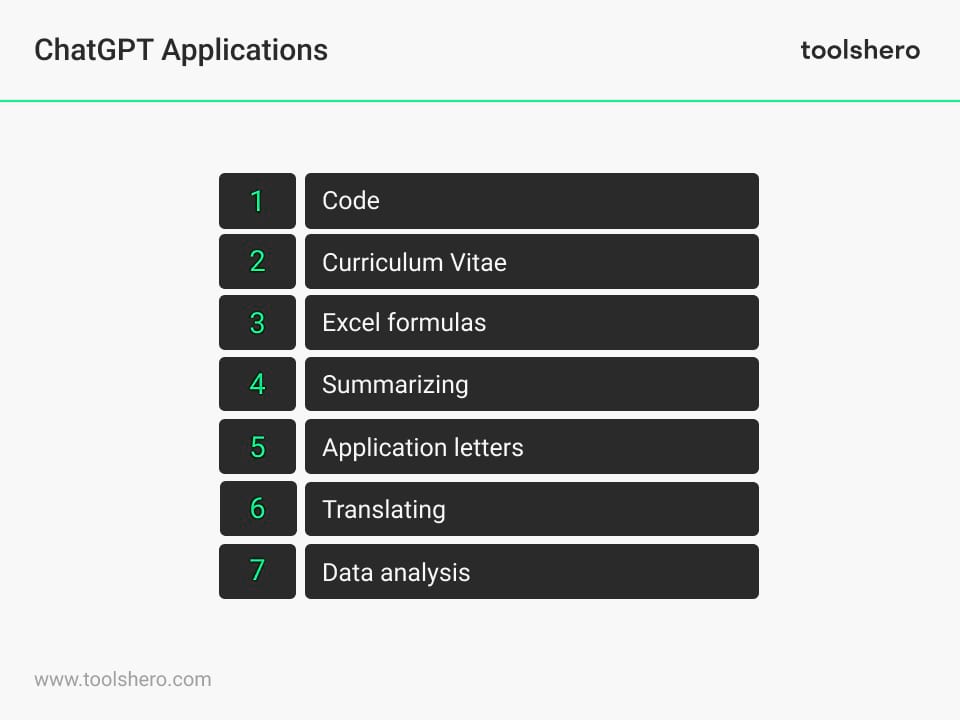ChatGPT: a great AI tool

ChatGPT: This article explains ChatGPT in a practical way. The article begins with the definition of this groundbreaking tool, followed by information about its development, examples, applications, dangers and pitfalls, and much more. Enjoy reading!
What is ChatGPT?
ChatGPT is an online natural language processing tool. It is powered by artificial intelligence and can be used to have human-like conversations, generate text such as emails, essays, as well as write computer code.
GPT-3.5 is currently freely accessible to everyone. In addition, version GPT-4.0 is available. For $20 per month, the user has access to the most comprehensive version of ChatGPT. The language model generates answers faster than the GPT-3.5 version and is equipped with advanced features such as browsing, plugins and advanced data analysis.
ChatGPT is developed by the company OpenAI, a research company. The tool was launched on November 30, 2022. The tool is easy to use through OpenAI’s website after creating a free account.
Many users start using this tool by asking the chat questions. There is no limit to the number of questions and assignments that can be given. An application is also available for Android and iPhone users.
Advanced applications GPT3.5 and GPT4.0
Although having a full conversation with a tool based on artificial intelligence is quite an experience in itself, the tool has many more useful applications. It can write essays, describe art, explain virtually any everyday process, have philosophical conversations, explain and code math calculations.
The possibilities reach far. Some examples of tasks that ChatGPT can help with are:
- Writing code
- Writing a CV
- Creating Excel formulas
- Summarizing texts
- Writing application letters
- Translation
- Data analysis

Figure 1 – Applications of ChatGPT
How does ChatGPT work?
The answers that ChatGPT gives can sometimes be astonishing. People wonder how it is actually possible for them to have a conversation with a computer. Here’s how it works.
Imagine that ChatGPT is a smart computer that is very good at talking and writing, but in actuality is not a real person. It is a program that is taught to understand what people are saying and asking.
Step 1: Learning from books and the internet
ChatGPT has learned from many books and texts. It has read on all kinds of topics, such as animals, history, and stories.
Step 2: Listening to people
People ask ChatGPT questions like “What’s the weather today?” or “Can you tell me a story?”.
Step 3: Thinking and answering
ChatGPT first takes a moment to think and then tries to give a good answer. It tries to remember what it has learned from books and texts.
Step 4: Talking back
When it comes up with a good answer, ChatGPT talks back and gives the answer to the person who asked the question.
It’s a bit like talking to a very smart robot that knows a lot. But remember it’s not a real person. Sometimes the answers can be wrong.
Limitations and shortcomings of ChatGPT
Some limitations of ChatGPT are:
Unable to fully understand complexities of human language
ChatGPT is trained to generate words based on input. This can make answers appear superficial and lack real insights.
Lack of knowledge about data and events
The training data ends with content from 2021. ChatGPT may provide incorrect information based on the data it draws from.
If ChatGPT does not fully understand the question, it may also provide an inaccurate answer. ChatGPT is still being trained, so feedback is recommended when an answer is incorrect. The GPT-4 version is able to read the internet and is more up to date.
It summarizes, but does not cite sources
ChatGPT does not provide any analytics or insight into data or statistics. The tool can provide various statistics, but does not really comment on what these statistics mean or how they relate to the topic.
Ethical concerns
ChatGPT is still in development and has created a great wave of fear and ignorance about its implications. Below you can read about the main objections people have when using artificial intelligence in chatbots.
Bias and discrimination
ChatGPT may display unintentional bias and discrimination in its answers. That’s because it’s been trained on massive amounts of text data that can contain human biases. This in turn can lead to unequal treatment of different groups of people.
Privacy and data security
The use of chatgpt statistics in data processing operations may raise privacy and security concerns. It can contain sensitive information that is not suitable for public distribution, leading to potential privacy violations.
Responsibility and liability
It is unclear who is responsible for ChatGPT’s actions when it makes mistakes or generates malicious content. This raises questions about accountability and responsibility.
Manipulation and abuse
ChatGPT can be misused to spread misinformation, spam, or even create fake news. It can also be used to manipulate or deceive people.
Does ChatGPT give wrong answers?
As described earlier, ChatGPT has limitations like all other language models. It is possible that nonsensical or incorrect answers are given. So it is important to check the generated data.
OpenAI itself advises users to provide as much feedback as possible about the answers the tool provides. In this way the tool is continuously improved.
Political bias
Researchers from England and Brazil have shown that ChatGPT generates responses in favor of Democrats in the US, the Labor Party in the UK, and Lula da Silva’s Labor Party in Brazil.
Concerns have been raised about the tool’s political bias before, but this is the first large-scale study using consistent and evidence-based analysis.
Does ChatGPT sometimes refuse to answer certain questions?
The release of ChatGPT to the general public has raised major concerns among people who are concerned about their jobs being taken over by AI. Partly for this reason, it is assumed that ChatGPT must be adamant in refusing to give advice for criminal purposes.
If the user asks the chat for criminal advice, the chatbot explains exactly why the activity is illegal and why certain laws have been introduced. Other times, the tool simply refuses to answer.
Challenges and dangers of ChatGPT
As indicated earlier in this text, the use of chatbots in general has some challenges and dangers. These are briefly summarized below.
Challenges
- Bias: ChatGPT’s answers can contain prejudice, bias, and discrimination because of the data it’s been trained on.
- Privacy and security: Using ChatGPT can cause privacy issues as it can share sensitive information.
- Responsibility: It is unclear who is responsible if ChatGPT makes mistakes or generates malicious content.
- Abuse: People can misuse ChatGPT for wrong purposes, such as spreading disinformation.
- Social impact: Overuse of ChatGPT can reduce human interaction and promote social isolation.
Dangers
- Loss of jobs: Automation by ChatGPT could lead to job losses in some industries.
- Bad information: ChatGPT can generate incorrect information and mislead people.
- Manipulation: It can be used to manipulate or deceive people.
- Incomprehension: ChatGPT cannot always properly understand complex questions and may give incorrect answers.
- Not citing sources: ChatGPT does not provide any sources for the information provided.
Can texts created by ChatGPT be detected?
The short answer to this is: yes. Texts generated by artificial intelligence can be detected, but only to a certain extent. Its detectability and accuracy scores depend on a number of factors. One is the length of the text.
An example of this is found in education. Many students choose chatbots like ChatGPT to write their essays. Many universities can detect the texts. A commonly used tool for this is ZeroGPT. It’s an AI detector tool to detect text generated by ChatGPT or any other AI chatbot.
The company behind ChatGPT, OpenAI has announced that it will add watermarks to answers provided by the bot. This makes it even easier to detect texts generated by AI.
Alternatives to ChatGPT
After the introduction of ChatGPT by OpenAI, the number of chatbots available has increased rapidly. Some of the most well-known tools are:
- Google Bard AI
- Perplexity AI
- Microsoft Bing
- JasPer.ai
- Chatsonic
There are many more. Each tool has its own advantages and disadvantages and is in a different development stage. Take the time to research which tool is best for the task at hand.
Now it’s your turn
What do you think? Do you recognize the explanation about ChatGPT? Have you already used the tool? If so, how do you use the tool? Mainly for entertainment? Or also for your education or work? What dangers and shortcomings do you see in using ChatGPT? Are you concerned about the ethical implications of this tool? Would you trust chatbots like these to make medical diagnoses? Or give legal advice? Why or why not? Do you have other tips or comments?
Share your experience and knowledge in the comments box below.
More information
- Adamopoulou, E., & Moussiades, L. (2020). An overview of chatbot technology. In IFIP international conference on artificial intelligence applications and innovations (pp. 373-383). Springer, Cham.
- Dahiya, M. (2017). A tool of conversation: Chatbot. International journal of computer sciences and engineering, 5(5), 158-161.
- Divya, S., Indumathi, V., Ishwarya, S., Priyasankari, M., & Devi, S. K. (2018). A self-diagnosis medical chatbot using artificial intelligence. Journal of Web Development and Web Designing, 3(1), 1-7.
- Biswas, S. S. (2023). Role of Chat GPT in public health. Annals of biomedical engineering, 51(5), 868-869.
How to cite this article:
Janse, B. (2023). ChatGPT. Retrieved [insert date] from Toolshero: https://www.toolshero.com/innovation/chatgpt-tool/
Original publication date: 09/07/2023 | Last update: 01/14/2024
Add a link to this page on your website:
<a href=” https://www.toolshero.com/innovation/chatgpt-tool/”> Toolshero: ChatGPT</a>










